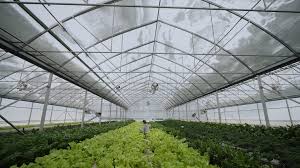Greenhouses serve as a protective barrier between plants and the outside environment. By creating a controlled space, they help prevent insects, rodents, and other pests from reaching the crops. Unlike open fields, where plants are constantly exposed to pests, a greenhouses allows growers to limit entry points and monitor for infestations. Screens and sealed doors reduce the risk of unwanted insects, while regular inspections help identify any early signs of pest presence. This containment significantly lowers crop losses and reduces the need for chemical pesticides, making the growing process healthier for both the plants and the environment.
Why Do Plants Experience Less Stress in Greenhouses?
Plants often undergo stress due to changing weather conditions such as wind, heavy rain, or temperature fluctuations. In a greenhouse, the environment is carefully controlled to maintain optimal conditions for growth. Temperature, humidity, and light levels can be adjusted according to the needs of specific crops. This stable environment minimizes stress, allowing plants to grow more vigorously and develop healthier leaves, flowers, and fruits. Reduced stress also means plants are less vulnerable to diseases and are better equipped to handle minor environmental changes.
What Role Does Climate Control Play in Pest Management?
Climate control is a major advantage of greenhouses when it comes to pest management. Many pests thrive under specific temperature and humidity conditions. By adjusting these factors, greenhouse growers can create an environment that is less favorable for pests while still being ideal for plant growth. For example, lowering humidity levels can prevent fungal growth, which is common in outdoor crops during wet seasons. This approach not only reduces pest damage but also supports stronger, healthier plants that can resist minor infestations naturally.
How Do Greenhouses Reduce the Need for Chemicals?
Because greenhouses limit pest access and allow for early detection, growers often need fewer chemical interventions. Instead of spraying pesticides regularly as a preventive measure, they can target treatments only when necessary. This reduces the amount of chemicals released into the environment and lowers the risk of pesticide residues on crops. Many growers also use natural pest control methods inside greenhouses, such as beneficial insects or traps, further minimizing chemical use. This sustainable approach supports both plant health and environmental safety.
Why Are Plants More Resilient in Greenhouses?
Plants grown in greenhouses are generally more resilient because they face fewer external stresses and receive consistent care. The controlled environment helps them maintain steady growth rates and reduces the risk of shock caused by sudden weather changes or pest attacks. Strong, healthy plants are better able to resist diseases and recover quickly if they do face minor pest damage. This resilience is particularly valuable for high-value crops, as it ensures consistent quality and yield.
What Makes Greenhouses a Long-Term Solution for Healthy Crops?
Greenhouses provide a long-term solution for maintaining plant health and reducing losses. They offer a protective environment year-round, allowing growers to plan production without worrying about seasonal pest outbreaks or extreme weather events. The combination of physical barriers, climate control, and careful monitoring creates a system where plants can thrive naturally. Over time, this reduces the dependence on reactive treatments and promotes sustainable, productive farming practices.
Conclusion: Are Greenhouses Worth the Investment?
Investing in a greenhouse can dramatically improve plant health and crop yield. By reducing pest damage, minimizing stress, and allowing for precise environmental control, greenhouses create ideal growing conditions. The result is stronger, healthier plants, fewer chemical interventions, and a more reliable harvest. For both small-scale and commercial growers, greenhouses offer a practical and effective way to protect crops while supporting sustainable agriculture practices. Plants inside a greenhouse are not just safer—they are given the best chance to grow strong and produce quality harvests.
















